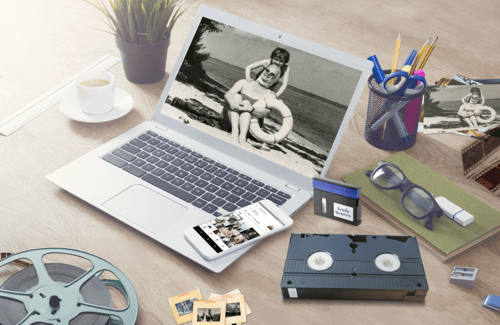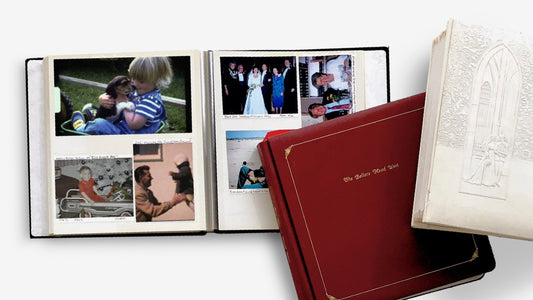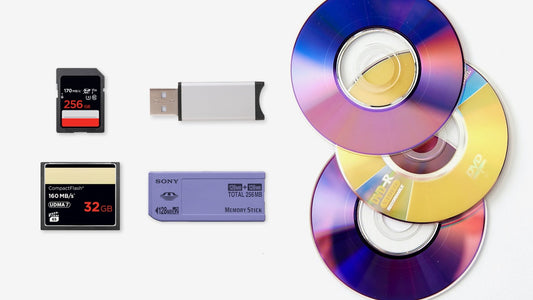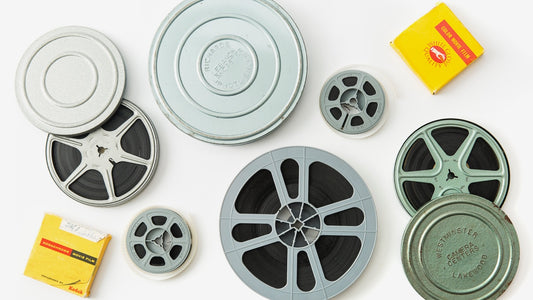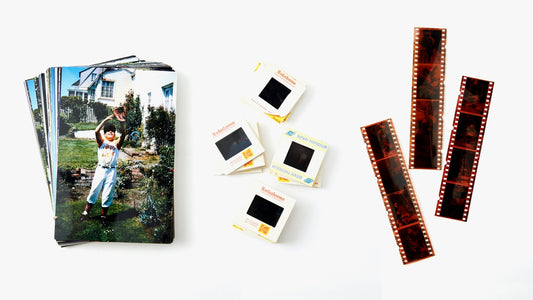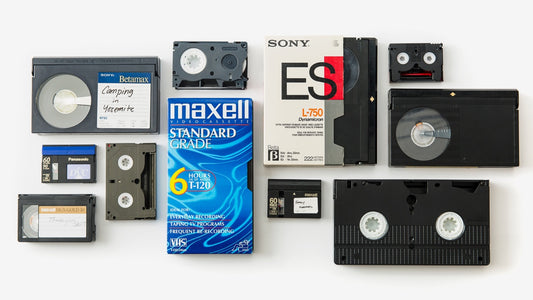Those carousels of photo slides sitting in the attic contain vibrant stories waiting to be told again. But without a projector and a dark room, they remain locked in the past. A slide scanning service brings these memories back into the light, converting them into beautiful digital photos you can access on any device. Suddenly, you can create photo books, share albums with relatives online, or post a throwback picture in perfect clarity. This guide covers everything from choosing the right resolution to what you can do with your new digital files, helping you finally enjoy and share your family’s history.
Key Takeaways
- Turn Fragile Slides into Lasting Memories: Digitization is the best way to protect your slides from fading and damage. It converts them into high-quality digital files that you can easily back up, share with family, and use for creative projects like photo books.
- Focus on Quality and Care, Not Just Cost: The right service balances price with essential features. Prioritize high-resolution scanning (DPI) for clear prints and look for a company that offers secure, hands-on handling to protect your irreplaceable originals.
- Organize Before, Back Up After: A little prep work makes a big difference. Group and label your slides before sending them to get an organized digital library in return. As soon as you receive your files, create backups on both a physical drive and a cloud service to secure your memories.
What Is a Slide Scanning Service?
If you’ve ever stumbled upon a dusty carousel of old photo slides in your parents’ attic, you know they hold a certain magic. These tiny windows to the past capture everything from candid family vacations to milestone celebrations. A slide scanning service takes these physical transparencies and transforms them into high-quality digital files. Think of it as a bridge connecting your family’s history to your modern life. Instead of needing a clunky projector and a dark room, you can access, view, and share these precious moments right from your computer or phone.
These services are designed to handle your memories with care. Professionals use specialized equipment to capture every detail and color from your 35mm, Super 35mm, 110, 126, and medium or large format slides. The goal isn’t just to create a digital copy; it’s to preserve the story behind each image for future generations. Beyond slides, many companies also offer photo transfer for loose prints and photo albums, ensuring all your visual memories can be safeguarded in one place. By digitizing your collection, you protect it from the fading, scratching, and decay that happens to physical media over time.
How Does Slide Scanning Work?
The process is surprisingly straightforward. You start by gathering your slides and sending them to the scanning company in a pre-paid, crush-proof box they provide. Once your collection arrives at their facility, trained technicians get to work. They carefully clean each slide by hand to remove dust and fingerprints before placing them in high-resolution scanners. This isn't a simple one-button operation; they handle each slide individually to ensure the best possible quality. After scanning, you receive your original slides back, along with your new digital photos on a USB drive, in a secure cloud account, or on a DVD.
Why You Should Digitize Your Slides
Digitizing your slides is one of the best ways to protect your family’s legacy. Physical slides are vulnerable—colors fade, and they can easily be damaged by moisture, heat, or accidents. Once they’re gone, those memories are gone forever. Creating digital copies gives you a permanent, high-quality backup that won’t degrade over time. It also makes your memories accessible again. You can easily share photos with relatives across the country, post them on social media, or create beautiful custom photo books. While a DIY approach might seem tempting, professional slide scanning services offer expertise and equipment that ensure your memories are preserved with the clarity and care they deserve.
The Best Slide Scanning Services
Choosing a company to handle your family’s memories is a big decision. You’re not just sending away little plastic squares; you’re trusting someone with irreplaceable moments from your life. The right service will treat your slides with the same care you would, using high-quality technology to create digital images you can easily share and enjoy for years to come.
To help you find the perfect fit, I’ve looked into some of the most popular slide scanning services out there. Each one has a slightly different approach, from pricing and resolution to turnaround time and extra features. Think about what matters most to you—whether it’s the highest possible resolution for printing, a simple all-in-one price, or the peace of mind that comes with a trusted name. This guide will walk you through your options so you can make a choice you feel great about.
YesVideo
With over 20 years of experience, YesVideo has built its reputation on trust and quality. We understand that every slide holds a precious memory, which is why every single order is processed by hand at our facility in the USA. Our photo transfer service is designed to be simple and secure. You send us your slides in a crush-proof box, and our team of experts carefully digitizes each one, ensuring the colors and details are preserved. You’ll get your original slides back along with your new digital copies on a DVD, USB, or in a private online account where you can view, download, and share your memories with family and friends anywhere.
ScanMyPhotos
ScanMyPhotos is a great option if you have a large, organized collection of slides. They offer a few different ways to pay, including a prepaid box that fits up to 540 slides for a flat fee, which can be very cost-effective. If you have a smaller batch, you can also pay per slide. They provide two main scanning resolutions: a standard 2000 DPI for viewing on screens and a premium 4000 DPI option for higher-quality images suitable for printing. This flexibility allows you to choose the service that best matches your budget and how you plan to use your digitized photos.
DigMyPics
DigMyPics stands out for its hands-on approach to quality. They scan every slide in-house and offer real-time order tracking online, so you can follow your memories throughout the entire process. They provide a range of resolution options, and each scan includes manual inspection, cropping, and rotation. What’s really helpful is their "pay only for what you want" model. After they scan your slides, you can review the digital images online and delete up to 20% of them, so you don’t have to pay for the blurry shots or duplicates. This gives you more control over the final cost and your finished collection.
Legacybox
You’ve probably seen Legacybox’s ads, and their process is built around simplicity. Instead of counting individual slides, you choose a box size based on the number of items you want to digitize. An "item" could be a bag of 25 slides, a videotape, or a film reel. You fill the box with your media, send it in, and they handle the rest. This all-in-one model is perfect if you have a mix of different media types to digitize, not just slides. They send you a welcome kit with everything you need, including pre-paid shipping labels, making the process straightforward from start to finish.
Memories Renewed
Memories Renewed is a smaller, specialized service that focuses on high-quality, personalized scanning. They are a good choice if you’re looking for meticulous attention to detail. They scan all slides at a high resolution of 4000 DPI, which is ideal for making large prints or zooming in on details without losing clarity. Each slide is also manually cleaned with compressed air before scanning to ensure the best possible image quality. Their process is very hands-on, making them a solid option for those who want a more boutique and careful approach to preserving their most important family slides.
Larsen Digital
Based in the US, Larsen Digital is another service that does all its scanning in-house, so your slides never get outsourced. They offer a "Value Scan" that provides excellent quality for a very competitive price. This option includes high-resolution 4000 DPI scanning, rotation, and auto color correction, giving you a lot of bang for your buck. They also have higher-tier options if you want more advanced editing. Larsen Digital is a family-owned business, and they pride themselves on their customer service, making them an approachable and reliable choice for your digitization project.
ScanCafe
ScanCafe is known for its affordable pricing, making it one of the most budget-friendly options available. They can offer lower prices because they perform the scanning work at their facility in India, but they still manage quality control from their US office. Their standard service includes a 10MP scan, which is great for digital viewing and sharing. One of their unique features is that they manually re-scan about a third of all images to ensure color and density are just right. Like DigMyPics, they also let you delete unwanted scans online before you pay, giving you control over the final cost.
Nostalgic Media
If you need your slides digitized quickly, Nostalgic Media is a fantastic option to consider. They boast an impressive average turnaround time of just seven business days, which is much faster than many other services. They scan slides at 3,200 DPI, creating high-quality JPEG files that are perfect for viewing on your computer, TV, or tablet, as well as for making standard-sized prints. Their focus on speed doesn’t mean they skimp on quality; they just have a streamlined process designed to get your memories back to you as quickly and safely as possible.
How to Choose the Right Service for You
With so many options out there, picking the right slide scanning service can feel like a big decision. After all, you’re trusting someone with your family’s irreplaceable memories. The good news is that by focusing on a few key factors, you can confidently choose a partner that fits your needs and budget. Think about what matters most to you—whether it’s crystal-clear image quality, a quick turnaround, or the ability to restore faded colors. Breaking it down this way makes the choice much simpler. Here’s a look at the most important things to consider.
Resolution and Quality
When you digitize a slide, resolution is everything. It determines how much detail is captured from the original, measured in Dots Per Inch (DPI) or megapixels (MP). A higher resolution means a sharper, clearer digital image that you can enlarge and print without it looking blurry. Some services offer scans up to 4000 DPI (about 18MP), which is fantastic for archiving and printing. When you’re comparing services, look for their standard resolution. While a basic scan is fine for viewing on a screen, a high-resolution photo transfer ensures your memories look their best for generations to come.
Turnaround Time and Safe Handling
It’s natural to want your slides back quickly, but it’s also important to make sure they’re handled with care. Turnaround times can range from a week to over a month, depending on the company’s process and whether you pay for expedited service. More importantly, find out how a company protects your originals. Are they processed by hand? Do they offer tracking so you can follow your order’s journey? At YesVideo, every order is processed by hand in the USA, because we believe your memories deserve a personal, careful touch from the moment they arrive until they’re safely sent back to you.
Pricing and Value
Pricing for slide scanning can vary quite a bit, so it’s helpful to understand the different models. Some companies charge per slide, while others offer prepaid boxes where you can fit a certain number of slides for a flat fee. The cheapest option isn’t always the best value. A slightly higher price might include better resolution, manual color correction, or more robust customer support. Think about the total package. For example, a service that also offers album scanning can provide a one-stop shop for all your photo preservation needs, which can be a great value in the long run.
Customer Support and Guarantees
Sending your family history to a company you’ve never used requires trust. That’s why great customer support and satisfaction guarantees are so important. Look for companies with positive reviews that mention helpful and responsive service. Can you easily contact someone if you have a question? Some services even offer a guarantee that allows you to review your scans and discard a certain percentage if you’re not happy, without being charged. A company that stands behind its work gives you peace of mind that your memories are in good hands.
Accepted Slide Formats
Before you pack up your collection, take a moment to see what kind of slides you have. The most common format is 35mm, but you might also have 110, 126, medium format, or even 3D stereo slides. Not every service accepts every format, so it’s crucial to check their website or contact them first. This simple step prevents the disappointment of sending in your slides only to find out they can’t be scanned. A versatile service that handles a wide range of photo transfer formats is ideal if you have a mixed collection of memories to preserve.
Photo Restoration Options
Over the decades, slides can fade, shift in color, or collect dust and scratches. If your collection has seen better days, look for a service that offers photo restoration. Many companies provide manual color correction and digital cleaning to remove imperfections, breathing new life into your old images. Some use a combination of AI technology and a human touch to fix common issues like the classic red-orange tint of aged film. These restoration options can make a dramatic difference, transforming a faded memory into a vibrant photo you’ll be excited to share.
How Much Does Slide Scanning Cost?
Figuring out the cost of scanning your slides can feel a bit like solving a puzzle. Prices vary from one service to another, and what you'll ultimately pay depends on a few key factors. The good news is that most companies are transparent about their pricing, so you won't be hit with surprise fees. The goal is to find a service that offers great value—balancing high-quality scans with a price that fits your budget. Think of it as an investment in protecting your family’s history.
This section will walk you through the typical costs, what influences the final price, and how you can find the best deal for your precious memories.
Breaking Down the Price
Most slide scanning services charge on a per-slide basis. This makes it simple to estimate your cost: just multiply the number of slides you have by the per-slide price. Generally, you can expect to pay anywhere from 30 cents to over a dollar per slide. This range often depends on the resolution you choose for your scans—higher resolution means a higher price, but also a more detailed digital image that’s perfect for printing and editing. Some companies offer prepaid, fill-the-box kits with a flat fee, which can be a great option if you have a large collection. Understanding the basic cost to scan documents can give you a solid baseline for what to expect as you start comparing different services for your slides.
What Affects the Final Cost?
Several factors can influence the total cost of your slide scanning project. The most significant is the scanning resolution, measured in dots per inch (DPI). A standard scan might be 2,000 DPI, while a high-quality scan could be 4,000 DPI or more. The volume of your slides also plays a big role; many services offer bulk discounts, so the per-slide price often goes down as your order size goes up. The type of slide can also affect the price, though most services have a standard rate for common formats like 35mm. Finally, the turnaround time you need can impact the cost. If you need your slides digitized in a hurry, you might have to pay for expedited processing.
The Cost of Add-On Services
Beyond the basic scan, many companies offer optional services that can add to the final price. These add-ons are designed to improve the quality of your digital images and make them easier to enjoy. Common extras include manual color correction, dust and scratch removal, and digital organization, where technicians will sort your photos into custom-named folders. When you receive your digital files, you’ll also have choices for delivery, such as a USB drive, a DVD, or cloud storage access. Some services, like YesVideo’s photo transfer, include many of these enhancements as part of their standard package, so be sure to check what’s included in the base price.
How to Find Deals
Everyone loves a good deal, and there are definitely ways to save on slide scanning. Keep an eye out for seasonal promotions, especially around holidays like Mother’s Day, Father’s Day, and Christmas, as these are popular times for memory-keeping gifts. Signing up for a company’s email newsletter is another great way to get notified about special offers. If you have a massive collection, look for services that offer bulk pricing, as your cost per slide can drop significantly. While it’s tempting to go with the absolute cheapest option, remember to consider the overall value. A slightly higher price might include better handling procedures, higher-quality scans, and more robust customer support, ensuring your memories are in the best possible hands.
How to Prepare Your Slides
Before you pack up your precious memories and send them off, taking a little time to prepare your slides can make a huge difference. Think of it as setting the stage for a successful digitization project. A bit of organization and light cleaning not only helps the technicians do their best work but also ensures your final digital photo collection is exactly how you want it—easy to navigate and looking its best. This prep work doesn't have to be a huge undertaking, but these simple steps will help streamline the process and protect your slides.
Organize and Label Your Collection
First, let's get your slides in order. Grouping them logically now will save you a ton of time later when you're trying to find that one specific photo of your grandpa's 70th birthday. You can sort them by year, event, or even by the people in them. Use rubber bands, small Ziploc bags, or index cards to separate your batches. Clearly labeling each group—like "Summer Vacation 1985" or "Christmas 1992"—is a game-changer. This helps the scanning service create organized digital folders for you, making your new digital archive a breeze to explore. It’s a simple step that makes the entire photo transfer process smoother for everyone involved.
Clean and Protect Your Slides
While any good scanning service will have its own cleaning process, you can give your slides a head start. Dust is the most common culprit, and you can gently remove it with a can of compressed air or a soft, anti-static brush. Hold the slide by its edges and give it a quick puff of air to dislodge any loose particles. For anything more stubborn, like fingerprints or smudges, it’s best to leave it to the pros. They have the right tools and expertise to clean delicate film without causing damage. The most important thing is to avoid using water or household cleaners, which can permanently ruin the emulsion. Your goal is simply to do a light dusting before sending them for their professional digital media transfer.
The Scanning Process: What to Expect
Handing over a box of irreplaceable memories can feel a little nerve-wracking. I get it. You’re trusting someone with moments that can never be recreated. That’s why it’s so important to understand what happens behind the scenes after you ship your slides. A professional service has a clear, secure process designed to protect your originals while creating the best possible digital copies. Let’s walk through what you can expect from a top-tier scanning service, from the moment your slides arrive to the moment they’re safely returned to you.
How Your Slides Are Handled
Your slides aren't just fed into a machine and forgotten. At a reputable service, experienced technicians handle every single slide by hand. They understand that these aren't just plastic squares; they're fragile pieces of your family's history. This hands-on approach is crucial for preventing damage and ensuring each slide is positioned correctly for a high-quality scan. Technicians are trained to work with various slide formats and conditions, treating your collection with the respect and care it deserves. This careful photo transfer process is the first step in preserving your memories for generations to come.
Ensuring Quality Control
Getting a great digital image involves more than just a scanner. The best services use a combination of advanced technology and a trained human eye to ensure top-notch quality. After the initial scan, each image is reviewed. Technicians look for common issues like dust, scratches, and color fading that can happen over decades of storage. They can often make manual adjustments to restore colors to their original vibrancy and clean up minor imperfections. This quality control step is what separates a basic scan from a professional digital restoration, giving you a final product that looks as good as—or even better than—the day the photo was taken.
Insurance and Safety Policies
Peace of mind is a huge part of the deal. From the moment your package arrives at the facility, a trusted service has strict safety protocols in place. Many facilities use surveillance cameras and detailed tracking systems to monitor your order every step of the way. Some companies even weigh your package upon arrival and before departure to confirm that everything you sent is accounted for. This meticulous attention to security ensures that your original slides are kept safe throughout the entire digitization process. When you choose a trusted service, you’re not just paying for a scan; you’re investing in a secure process designed to protect your most precious memories.
After the Scan: What to Do With Your Digital Photos
Getting your slides digitized is a huge win, but the fun really begins once you have the digital files in hand. This is your chance to bring those memories back into your life, share them with the people you love, and make sure they’re safe for good. Instead of letting them sit in another digital folder, here are a few simple ways to organize, store, and enjoy your newly scanned photos.
Choose Your File Formats and Storage
Once your slides are scanned, you’ll receive your images as digital files. Most services, including YesVideo, offer a few delivery options, like a digital download, a USB drive, or cloud storage. The most common file format is JPEG, which is perfect for its balance of quality and manageable file size, making it easy to share online or via email. Your first step should be to back up these precious files. Create at least two copies: one on a physical device like an external hard drive and another on a secure cloud service. This ensures that no matter what happens to your computer, your memories are protected. You can even consolidate all your digital files from different sources into one organized library.
Share and Display Your Memories
Now you can finally free those photos from their tiny slide frames. The goal of a photo transfer is to make your memories accessible again. You can easily create a digital slideshow with music to watch on your TV for a family movie night—a perfect way to introduce younger generations to their family history. Share your favorite shots on social media or create a shared online album for relatives to browse and download their own copies. You can also use the high-resolution images to print beautiful photo books, create custom calendars for holiday gifts, or finally frame that one perfect shot of your parents on their wedding day. The possibilities are endless.
Common Mistakes to Avoid When Choosing a Service
Choosing a company to handle your family’s irreplaceable slides can feel like a big decision, because it is. You’re not just buying a product; you’re entrusting someone with your memories. Taking a little time to consider your options can help you avoid common pitfalls and ensure your precious moments are in the right hands.
Skipping the Research
It’s tempting to pick the first service you find, but your slides are one-of-a-kind. Take a moment to read online reviews and testimonials to get a real sense of a company’s track record. A reputable service will have experienced technicians who know how to handle fragile, aging slides with care. Look for a company that is transparent about its process and has a history of satisfied customers. This little bit of homework ensures your memories are in safe, expert hands.
Ignoring Resolution Options
Resolution, or DPI (dots per inch), directly impacts the quality of your digital photos. While a lower-resolution scan might be cheaper, it can result in pixelated images if you try to print or enlarge them. A higher DPI captures more detail, which is essential for cropping a photo or zooming in on a specific face. As one reviewer noted, a 4000 DPI scan makes a clear difference. Think about how you’ll use your photos in the future; investing in a higher resolution now gives you more options later.
Forgetting About How Your Slides Are Returned
The process isn’t over until your original slides are safely back with you. It’s an easy detail to miss, but always ask how a company handles return shipping. Will they be packed in a sturdy box or a flimsy envelope? One customer was disappointed when their order arrived in a soft mailer, risking damage to their originals. A trustworthy service treats your slides with care throughout the entire photo transfer process, and that includes a secure trip home.
Not Asking About Photo Organization
If you’ve already sorted your slides, you don’t want to receive a folder of randomly named digital files. Before committing, ask if the service can preserve your organization. Can they keep your slides in order and create custom-named folders? Services that handle album scanning often understand the importance of keeping your story straight. Clarifying this upfront will save you the headache of re-sorting hundreds of digital photos later on.
Related Articles
- Digitize Slides: The Ultimate 2025 How-To Guide – YesVideo
- Convert Slides to Digital Pictures: DIY & Pro Guide – YesVideo
- How to Transfer Slides to Digital: DIY & Pro Guide – YesVideo
- 4 Ways to Convert Photographic Slides to Digital – YesVideo
- Photo Slides: A Comprehensive Guide (2023) – YesVideo
Frequently Asked Questions
Do I need to take my slides out of the carousels or metal boxes before sending them in? This is a great question, and the short answer is that it depends on the service you choose. Most companies, including YesVideo, prefer that you remove the slides and bundle them into labeled groups. This helps ensure that every single slide gets the individual attention it needs during the cleaning and scanning process. Taking a few moments to organize them yourself also guarantees your digital folders will be arranged exactly how you want them when you digitize photos for safekeeping and sharing.
Is it really worth paying for a service when I could just buy a scanner and do it myself? While you can certainly buy a home slide scanner, a professional service offers a level of quality and efficiency that’s tough to match. The equipment used by professionals is far more advanced than consumer-grade models, capturing much higher resolution and better color depth. Beyond the technology, you're also paying for expertise and time. Technicians handle your fragile slides with care, and they can digitize hundreds or thousands of images much faster than you could on your own. It’s an investment in getting the best possible results without spending your weekends in front of a scanner.
What if some of my slides are really faded or have that weird red tint? Can that be fixed? Yes, in many cases it can. That reddish or magenta color cast is very common in older film, and it’s something professional technicians see all the time. Most high-quality services include manual color and contrast correction as part of their process. While they can’t work miracles on severely damaged slides, they can often restore much of the original vibrancy, correct color shifts, and digitally clean up dust and minor scratches, making the images look better than they have in decades.
What's the real difference between getting my photos on a USB versus a cloud account? Think of it as having a physical key versus a digital key. A USB drive is a physical copy you can hold in your hand, plug into any computer, and store in a safe place. A cloud account gives you instant access to your entire collection from any device with an internet connection, making it incredibly easy to share photos with family and friends. Many people find that the best approach is to get both—a USB for a permanent backup and a cloud account for easy viewing and sharing.
Will my original slides be returned to me, and will they be in the same condition? Absolutely. Any reputable slide scanning service understands that your original slides are irreplaceable. The entire process is designed to protect them. Your slides are handled carefully by trained technicians, and after the digital copies are made, your originals are securely packaged and shipped back to you. A trustworthy company will always return your originals, often with tracking information so you have peace of mind throughout the entire journey.





